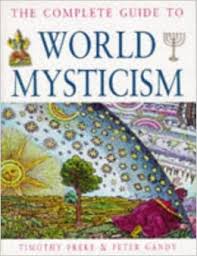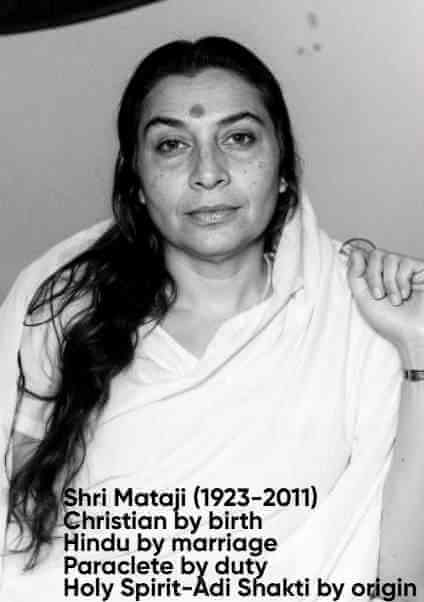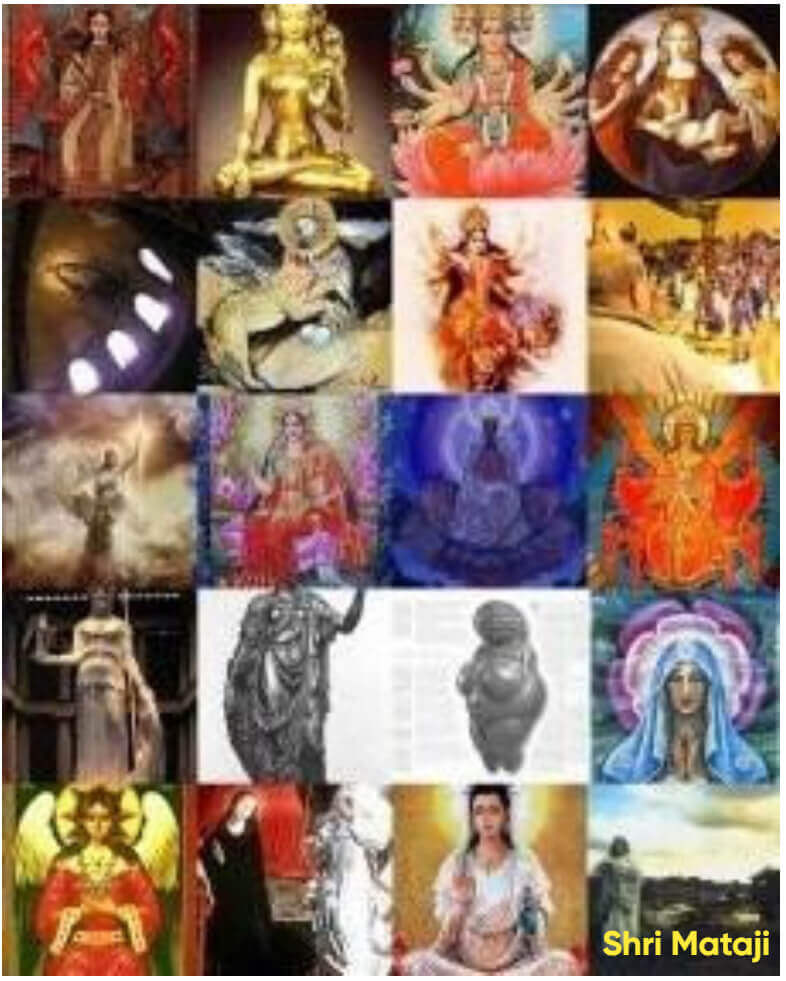The mystics offer us their personal testimonies that this hunger can be satisfied through a direct experience of the mystical dimensions of life.
In every age, mystics have spoken of the unseen—of visions, vibrations, and the silent presence of the Divine. This page gathers their voices, each a living testimony to the Adi Shakti’s descent and the eschatological awakening now unfolding. From the Cool Breeze to the inner light, these experiences are not metaphor—they are proof. The Divine Feminine walks among us, and Her children are beginning to remember.

“Mysticism begins with the extraordinary experience of the ancient
shamans of the primal people who, through the use of ritual and
psychedelic plants, began an exploration of the mysteries of
consciousness. In India this wisdom flowered into a profound
philosophy which gradually influenced the whole of the ancient world.
Ancient Egypt also developed a similar mysticism, which gave birth to
the Mystery Schools — spiritual 'universities' for mystical
initiation. The philosophies of India and Egypt came together in
ancient Greece. Here, the Mystery Schools flourished as a religion
for a thousand years, and left a legacy that would inspire all
subsequent Western mystics.
The relationship of mysticism to religion has been characterized by a
cycle of living revelation bringing life to dead tradition, only to
fall in turn into religious orthodoxy. In sixth-century BC India, the
Buddha experienced enlightenment and challenged the authorities of
the Hindu religion, becoming the founder of a new mystical faith. In
China, his contemporary Lao Tzu revitalized the Taoist tradition with
profound mystical ideas. In the first century AD the Jewish mystic
Jesus challenged the spiritual authority of the religious hierarchy
in Israel, and initiated the Christian religion. Whilst the mystical
spirit can still be found in all these faiths up until the present
day, they have all to a greater or lesser degree slipped into the
dogma and superstition of religion.
Each mystical tradition has gone through different high points and
low points. Jewish mysticism reached its heights with the Kabbalists
of the Middle Ages and the Hasids of the eighteen century. Christian
mysticism was most vibrant among the early Gnostics of the first
century AD and the Friends of God of the thirteen and fourteen
centuries. Islamic mysticism flowered with the Sufis of the tenth to
twelfth centuries. All traditions have had their great saints and
sages, who directly experienced the eternal truth and left a legacy
of spiritual inspiration for those who followed. However, it is only
India, The Mother of mysticism, which has continually produced
numbers of great enlightened masters. India's influence has once
again been felt in the modern West. After the explosive increase in
the use of mind-altering drugs in the 1960s, huge numbers of people
looked again to the East to find spiritual context for their strange
experiences, inspiring the new wave of mysticism we are experiencing
today.
In the modern world, there is growing disillusionment with orthodox
dogmatic religion and scientific materialism: neither can satisfy the
deep inner yearning of the soul. This has led to a profound spiritual
hunger. The mystics offer us their personal testimonies that this
hunger can be satisfied through a direct experience of the mystical
dimensions of life. This vision may be glimpsed through the window of
any one of their accounts of rapture and their inspired insights.
These are the gifts of wisdom that we have inherited from those great
souls who have pierced the veil of everyday reality, and beheld the
timeless mystical truth.”
Timothy Freke and Peter Gandy, The Complete Guide to World Mysticism
Piatkus Books; New Ed edition (October 1998) pp. 16-17
The Perennial Hunger for Mystical Experience: A Critical Examination of Historical Traditions and Modern Claims
Abstract
This paper examines the cyclical nature of mystical traditions as described by Timothy Freke and Peter Gandy, critically analyzing their claims about the high points of Jewish, Christian, and Islamic mysticism. It further investigates the assertion that the contemporary spiritual movement Sahaja Yoga, founded by Shri Mataji Nirmala Devi, represents a modern fulfillment of the universal mystical quest, particularly through the claimed opening of the Sahasrara Chakra on May 5, 1970. By contextualizing historical mystical flowerings and evaluating the claims of a new religious movement, this paper explores the enduring human hunger for direct spiritual experience.
Introduction
Timothy Freke and Peter Gandy, in their popular work The Complete Guide to World Mysticism, posit that "each mystical tradition has gone through different high points and low points."[1] They suggest that while various traditions have had their "great saints and sages," it is "only India, The Mother of mysticism, which has continually produced numbers of great enlightened masters."[1] This assertion, while compelling, warrants a critical examination of its historical accuracy and its implications for understanding the nature of mysticism. This paper will first assess the historical validity of Freke and Gandy's claims regarding Jewish, Christian, and Islamic mysticism. It will then turn to a modern case study, the Sahaja Yoga movement, and its central claim that the "hunger can be satisfied through a direct experience of the mystical dimensions of life," a truth they claim has been "abundantly proven" through the work of their founder, the Paraclete Shri Mataji Nirmala Devi, and the metaphysical experiences of children entering the Sahasrara Chakra.[2]
Historical Peaks of Mystical Traditions
Freke and Gandy identify specific "high points" for several major mystical traditions. A closer look at these periods reveals a more complex and nuanced history than their summary suggests.
Jewish Mysticism: Kabbalah and Hasidism
Freke and Gandy are correct in identifying the Middle Ages as a significant period for Jewish mysticism, particularly with the emergence of Kabbalah. The Zohar, the foundational text of Kabbalah, appeared in the 13th century in Spain, marking a pivotal moment in the development of Jewish esoteric thought.[3] Similarly, the 18th century witnessed the rise of Hasidism in Eastern Europe, a movement that popularized Kabbalistic ideas and emphasized direct, ecstatic experience of God.[4] However, to characterize these as isolated "high points" overlooks the continuous thread of mystical thought that runs through Jewish history, from the early Merkavah mystics to the present day.
Christian Mysticism: Gnostics and the Friends of God
The authors point to the early Gnostics of the first century and the Friends of God in the 13th and 14th centuries as high points of Christian mysticism. The Friends of God, a medieval mystical group in the Rhineland, did indeed represent a significant flowering of mystical piety, influenced by figures like Meister Eckhart.[5] However, the inclusion of the Gnostics is more problematic. While the Gnostics certainly had a mystical dimension, their relationship to mainstream Christianity is complex and often antagonistic. To present them as a vibrant peak of "Christian" mysticism is a simplification that ignores the theological battles of the early church.
Islamic Mysticism: The Sufis
Freke and Gandy's assertion that Islamic mysticism "flowered with the Sufis of the tenth to twelfth centuries" is broadly accurate.[1] This period saw the emergence of major Sufi orders and the systematization of Sufi thought by figures like Al-Ghazali. However, as with other traditions, Sufism has a long and rich history that extends both before and after this specific timeframe. The roots of Sufism can be traced back to the earliest days of Islam, and it continues to be a vibrant tradition in many parts of the world.[6]
A Modern Mystical Claim: Sahaja Yoga and the Sahasrara Chakra
The website adishakti.org, a central resource for the Sahaja Yoga movement, makes a bold claim: that the universal hunger for mystical experience has been "abundantly proven" through the metaphysical experiences of children entering the Sahasrara Chakra, the "Kingdom of God," which they believe was opened by their founder, the Paraclete Shri Mataji Nirmala Devi, on May 5, 1970.[2]
Shri Mataji Nirmala Devi (1923-2011) founded Sahaja Yoga in 1970, claiming to have been born "fully realized."[7] The movement teaches a form of meditation intended to produce a state of "self-realization" through the awakening of the kundalini energy. The opening of the Sahasrara Chakra, the thousand-petaled lotus at the crown of the head, is seen as the culmination of this process, leading to a direct experience of the divine.
“The mystics offer us their personal testimonies that this hunger can be satisfied through a direct experience of the mystical dimensions of life”
— Timothy Freke and Peter Gandy
The claims of Sahaja Yoga, and specifically the assertion that the opening of the Sahasrara Chakra on a specific date by a specific individual has "abundantly proven" the satisfaction of the mystical hunger, are difficult to assess from an academic perspective. While the movement has been the subject of some scholarly study, primarily in the fields of sociology and religious studies, its claims remain a matter of faith for its followers.[8]
Critical Analysis and Conclusion
Freke and Gandy
Freke and Gandy's work, while popular, has been criticized for its lack of scholarly rigor.[9] Their tendency to generalize and simplify complex historical phenomena is evident in their depiction of mystical "high points." While they correctly identify periods of significant mystical activity, their framework of discrete peaks and troughs fails to capture the continuous and evolving nature of these traditions. Mysticism is not a series of isolated eruptions but a perennial stream flowing through human history, sometimes as a public river, sometimes as a subterranean current.
The claim from adishakti.org presents a different kind of challenge. It is a faith-based assertion that a specific event—the opening of the Sahasrara Chakra by Shri Mataji—is the ultimate fulfillment of this mystical hunger. From a scholarly perspective, such a claim is unfalsifiable and lies outside the realm of empirical verification. It is a testament to the power of personal experience and the role of charismatic leaders in modern spirituality. The movement's emphasis on direct, experiential knowledge, accessible through a specific technique, echoes the core promise of mystical traditions throughout history.
In conclusion, the "hunger for a direct experience of the mystical dimensions of life" is a powerful and enduring force in human culture. Freke and Gandy, despite their scholarly shortcomings, effectively articulate this perennial quest. The historical traditions they cite, from Kabbalah to Sufism, offer rich and diverse pathways to this experience. Modern movements like Sahaja Yoga demonstrate that this quest is very much alive today, adapting ancient concepts to a contemporary context. While the historical claims of Freke and Gandy require critical nuance, and the spiritual assertions of Sahaja Yoga remain a matter of personal testimony, both point to the same fundamental truth: the human spirit's unceasing search for a direct encounter with the divine.
References
[1] Freke, T., & Gandy, P. (1998). The Complete Guide to World Mysticism. Piatkus Books.[2] "Adi Shakti: The Divine Feminine." adishakti.org, accessed Oct 3, 2025.
[3] "Kabbalah." Wikipedia, Wikimedia Foundation, 2 Oct. 2025.
[4] "Kabbalah and Hasidism." The Pluralism Project, Harvard University, accessed Oct 3, 2025.
[5] "Friends of God." Wikipedia, Wikimedia Foundation, 15 Sept. 2025.
[6] "Sufism." Wikipedia, Wikimedia Foundation, 28 Sept. 2025.
[7] "Nirmala Srivastava." Wikipedia, Wikimedia Foundation, 25 Sept. 2025.
[8] Coney, J. (1999). Sahaja Yoga: Socializing Processes in a South Asian New Religious Movement. Curzon Press.
[9] Elliott, S. M. (2011). "Pseudo-Scholarship Illustrated." The Fourth R, 24(3).


